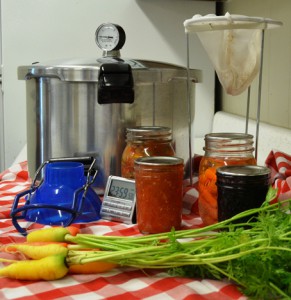Home canning has changed greatly in the 170 years since it was introduced as a way to preserve food. Grandma may have cooked her green beans and poured them into hot jars but open kettle canning is not recommended today. Scientists have found ways to produce safe, higher quality products to replace outdated recipes and techniques.
For safety’s sake, pressure canning is the only recommended method for canning meat, poultry, seafood and vegetables. Only through the use of the proper equipment can bacteria be destroyed in low-acid foods when they are processed at the correct time and pressure. Using boiling water canners for these foods poses a real risk of botulism poisoning. If Clostridium botulinum bacteria survive and grow inside a sealed jar of food, they can produce a poisonous toxin. Even a taste of food containing this toxin can be fatal.
What are the secrets of a safe and quality end-product? Process low-acid foods in a pressure canner. Have your gauge checked for accuracy and your gasket for dryness; many county extension offices offer this service. Make sure that you are using up-to date, research-based processing times and pressures for the size of jar, style of pack and kind of food being canned. Utilize the proper processing time and pressure for sterilizing the food at your altitude. Look for jar lids that are firmly sealed and concave and with nothing leaking from the jar after storage. Upon opening the jar, no liquid should spurt out and no unnatural or “off” odors should be detected.
Research-based food preservation recipes and information are available at your county extension office or at the UF/IFAS website http://edis.ifas.ufl.edu/topic_canning_food. When preserving low-acid food there is no room for error. The safety and quality of the end product are factors to be considered.
- Putting the WOW in Halloween - September 25, 2016
- Families Should Play Together for Exercise - May 19, 2016
- Sweets for Your Sweetie - January 15, 2016

